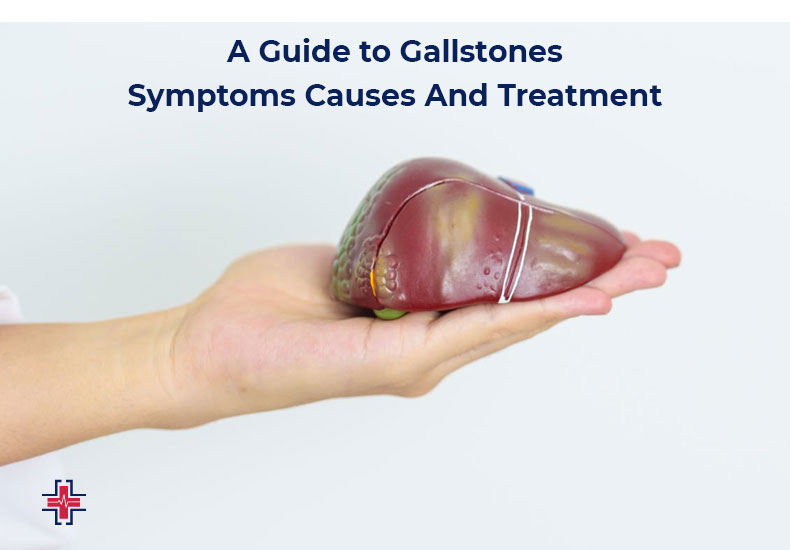Gallstones are widespread, and they rarely cause problems for most people. You won’t likely ever be aware of them if they remain in your gallbladder. But when they move, that’s when they get dangerous. When these tiny, pebble-like fragments get into the small openings in your vulnerable biliary system, they can cause a great deal of harm.
A gallbladder attack can be frightening and severe, particularly if you were unaware that you had gallstones in the first place. The news that surgery is the suggested course of action may seem frightening. However, laparoscopic removal of the gallbladder is a routine treatment with a good outcome. Your early symptoms could go away in a matter of hours, ending your agony.
What Are Gallstones?
Your body stores bile in the gallbladder, a tiny, pear-shaped organ, which is where gallstones originate. They are concentrated bile components in the form of pebble-like particles. Bile salts, lecithin, bilirubin, and cholesterol are all found in bile fluid. Usually composed of cholesterol or bilirubin, gallstones build up in the bottom of the gallbladder and eventually solidify into “stones.”
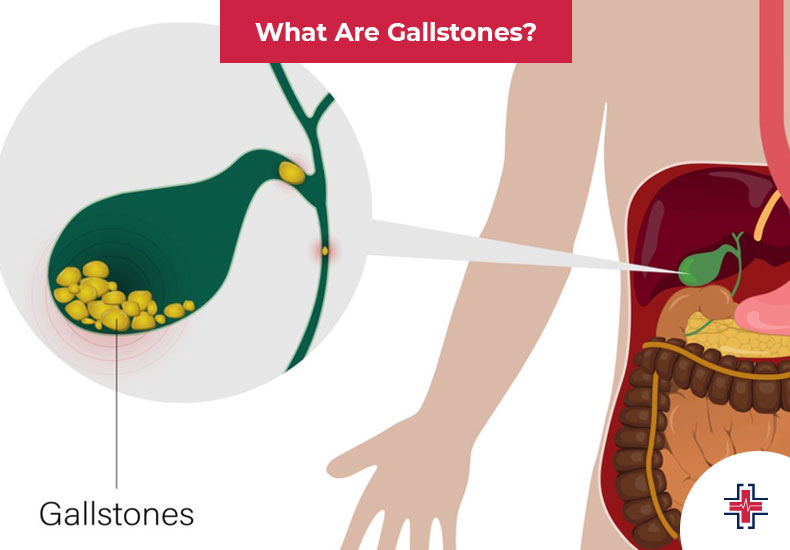
The size of a gallstone ranges from that of a golf ball to that of a grain of sand. They progressively enlarge as more materials are gathered and bile keeps washing over them. The stones that are more prone to create problems are the smaller ones. This is because larger stones tend to stay there, whereas smaller ones can move. Traveling gallstones have the potential to become lodged and cause a blockage.
Is It Dangerous To Have Gallstones?
The majority of gallstones don’t pain or pose a health risk. Treatment for these “silent gallstones” is usually not necessary. But if you experience sudden, intense pain that lasts for hours, you should seek medical attention straight once. This could be a dangerous indication that you have gallstones lodged in your bile duct.
What is Cholelithiasis?
Gallstones are a symptom of cholelithiasis. Many people do not realize they have cholelithiasis. You won’t necessarily have any issues with gallstones. You can leave them alone if they don’t. However, gallstones can occasionally cause issues by obstructing the flow of fluid. Your organs will become inflamed and in discomfort as a result. It can lead to very significant problems if left untreated.
Gallstone Pancreatitis: What Is It?
Although there are some potential causes for acute pancreatitis or inflammation of the pancreas, gallstones are the most common. Because the etiology, course, and treatment of pancreatitis caused by gallstones differ from those of other kinds of pancreatitis, healthcare professionals make this distinction. A gallstone is obstructing the pancreatic duct in gallstone pancreatitis, also known as biliary pancreatitis. Inflammation results from the obstruction. Gallstone pancreatitis cannot be healed unless the gallstone passes or is removed.
What Are The Effects of Gallstones (Cholelithiasis) On Me?
A component of your biliary system is your gallbladder. It is a part of an organ network that exchanges bile between itself. The bile ducts, a network of pipes, connect these organs. From your liver to your gallbladder and from your gallbladder to your small intestine, bile is transported via the bile ducts. The bile ducts are also used by your pancreas to distribute its digestive juices.
Bile cannot pass through the mouth of your gallbladder if you have a gallstone that gets there. A gallstone can enter your bile ducts from your gallbladder and obstruct the flow of bile via them. Bile will back up into the surrounding organs as a result of this. Your organs and bile ducts experience pressure, pain, and inflammation when bile backs up.
Numerous issues may arise from this, such as:
- Gallbladder Illness. The most frequent cause of gallbladder disorders is gallstones. They irritate when they become lodged because bile backs up into your gallbladder. Over time, this may cause permanent harm to your gallbladder by leaving scars on the tissues and impairing its ability to operate. Additionally, the slowed bile flow increases your risk of gallbladder infections.
- Pancreatitis due to gallstones. Pancreatitis is the result of an obstruction in the pancreatic duct caused by a gallstone. Similar to your other organs, acute inflammation results in pain, but chronic inflammation damages your organ over time and may even cause it to stop working.
- Cholagiitis. Long-term scarring and short-term infections can result from inflammation in your bile ducts. Your bile ducts narrow as a result of scarring, which limits the flow of bile. Long-term bile flow issues may result from this, even after the obstruction has been cleared.
- Inadequate absorption. You may have trouble digesting and absorbing nutrients from your meals if bile is unable to reach your small intestine as it should. In the small intestine, bile is especially crucial for the breakdown of fats and the absorption of fat-soluble vitamins.
Types of Gallstone
There are two types of Gallstone:
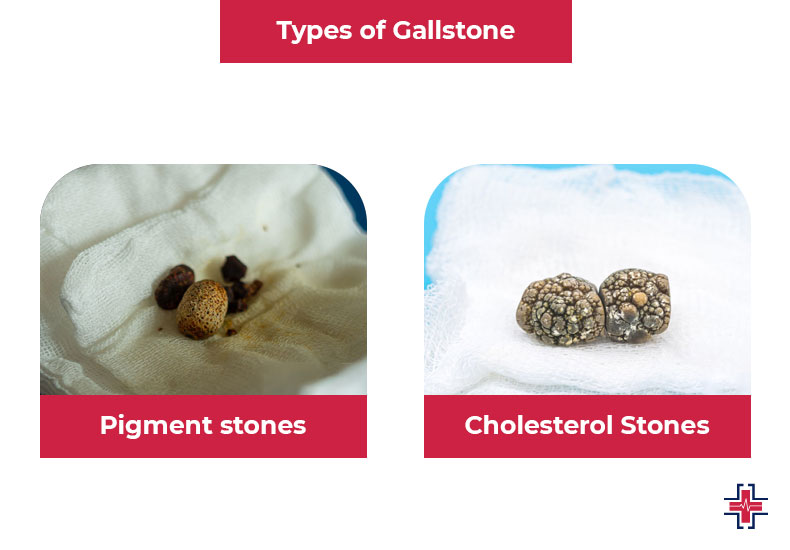
Pigment Stones
These are primarily bilirubin-based dark or black stones. Those who get them typically have leukemia or sickle cell anemia, or they have liver illness.
Cholesterol Stones
Since they are primarily composed of undissolved cholesterol, they are often yellow-green. However, they may also contain other substances like bilirubin or bile salts. They account for around 80% of gallstones and are the most prevalent.
Gallstone Pain
Gallstones that obstruct your bile ducts might cause your gallbladder to spasm. This could cause you to experience a sudden, sharp stabbing or cutting pain. You could find it difficult to breathe due to the intense pain in your abdomen. A few folks believe they are experiencing a heart attack.
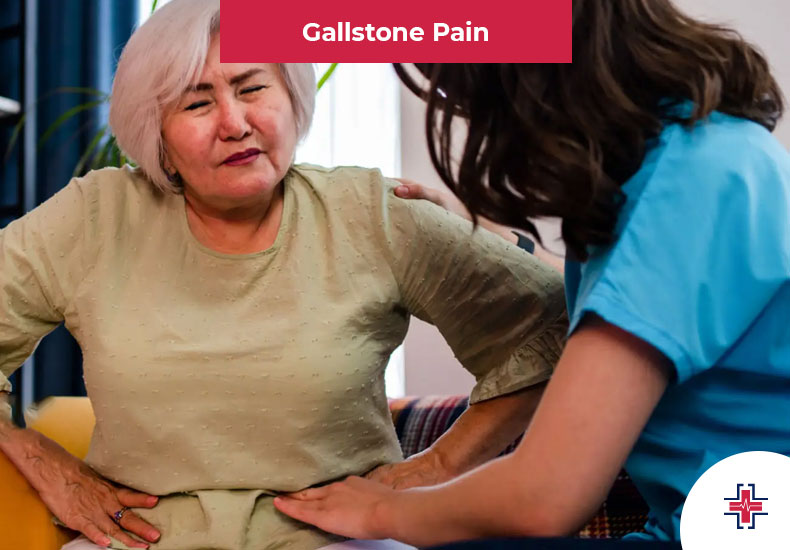
What Are Gallstone Pancreatitis Symptoms?
Gallstones often cause no symptoms at all in their sufferers. These are frequently discovered while doing an abdominal surgery, standard x-ray, or other medical operation.
A huge stone, however, might obstruct a duct or tube that drains the gallbladder, causing cramping in the middle to the upper right abdomen. Biliary colic is the term for this. If the stone enters the first segment of the small intestine, the pain stops.
Possible symptoms include:
- For at least half an hour, upper or middle abdominal pain on the right side. The pain could be cramping or persistent. It could feel dull or sharp.
- High temperature.
- Jaundice is the yellowing of the skin and eye whites.
Additional signs and symptoms could be:
- Stools with a clay color
- Vomiting and nausea
What Are The Main Causes of Gallstones?
Up to 75% of gallstones that medical professionals find are composed of too much cholesterol. Therefore, we could conclude that the main cause of gallstones is having an excess of cholesterol in the blood. There are several reasons why you could have elevated cholesterol. Obesity and diabetes are two metabolic illnesses that are among the most prevalent causes.
Higher levels of cholesterol in your bile are caused by high blood cholesterol. Before the bile is sent to your gallbladder, your liver removes cholesterol from your blood and stores it in the bile as waste. Bile salts and lecithin are the chemicals in bile that are designed to dissolve cholesterol. However, these compounds may not be sufficient if present in excess.
- Excess bilirubin: Rather than cholesterol, excess bilirubin makes up about 25% of gallstones. A consequence of your liver’s breakdown of red blood cells is bilirubin. Your liver may create more bilirubin than usual while trying to function due to certain medical conditions. Among them include liver illness, blood abnormalities, and infections.
- Stasis of the gallbladder: When your body needs to break down fats, your small intestine tells your gallbladder to send bile. In a healthy gallbladder, it contracts effectively to expel bile as needed. Nevertheless, some bile can remain behind if your gallbladder doesn’t constrict thoroughly enough. This bile eventually condenses into a form of sludge that eventually crystallizes at the gallbladder’s bottom.
Who Gets Gallstones?
Gallstones can affect anyone, even young children, but they become more prevalent after the age of 40. This is due to the extremely slow growth of gallstones. Gallstones might take ten to twenty years to enlarge to the point where they impede flow. Additionally, there is a 3:1 ratio of greater prevalence in individuals classified as female at birth compared to those assigned as male. The impacts of female hormones are to blame for this.
Additional typical risk factors consist of:
- Mexican or Native American ancestry. A hereditary profile of elevated cholesterol levels is shared by these individuals.
- Syndrome of metabolism. The likelihood of cholesterol gallstones is influenced by some metabolic risk factors, such as insulin resistance, high blood triglycerides, and overweight.
Progesterone reduces gallbladder spasms whereas estrogen raises cholesterol. During specific times in your reproductive life, such as when you are pregnant or menstruating, both hormones are particularly elevated. Many people take hormone treatment (HT) to replenish their declining hormone levels throughout menopause, which raises them back up.
Additionally, there is a higher likelihood of body fat gain and loss in women and those classified as female at birth. More body fat can result in higher blood cholesterol levels. Obesity raises estrogen levels. Conversely, weight increase and quick weight decrease have comparable effects. Suddenly losing a lot of body fat causes your liver to metabolize an abnormally high amount of cholesterol, which ends up in your bile.
Gallstones: How Are They Diagnosed?
Your healthcare provider will use imaging and blood tests to determine whether you have biliary colic. Blood testing can identify jaundice, infections, or inflammation. Additionally, they may provide hints to your healthcare physician regarding the organs that are impacted. Imaging examinations will assist in identifying the blockage’s origins. Typically, they will begin with an ultrasound.
Gallstones are a possible diagnosis for your symptoms when they are accompanied by discomfort in the upper right side of your abdomen. To rule out other illnesses, such as tumors, irritable bowel syndrome, and stomach ulcers, testing is occasionally necessary. The most frequent investigations are blood tests and ultrasound scans. Sometimes more research, such as other scan types, is necessary.
Treatment of Gallstone
If you don’t have any symptoms, you normally don’t need treatment because some little gallstones can pass through your body naturally. However, there are strategies to manage a gallbladder attack or lower the risk of gallbladder issues.
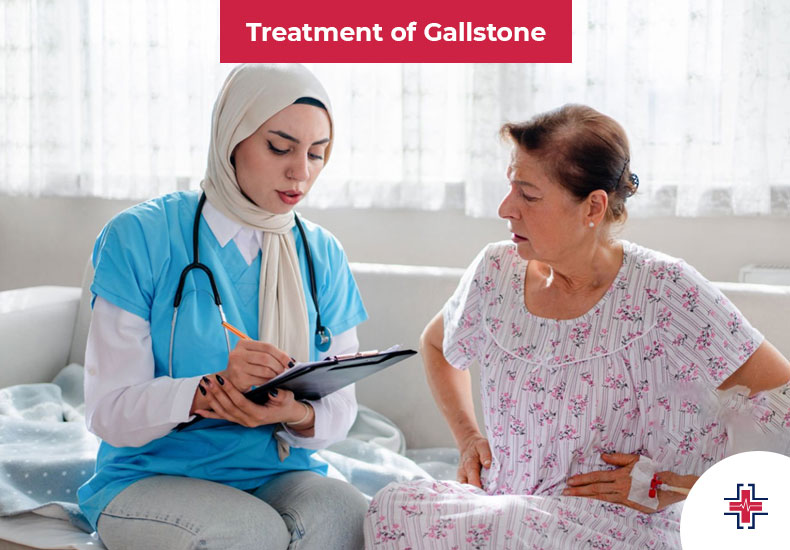
The majority of gallstone sufferers never need medical attention. However, your healthcare physician will want to remove your gallstones if they become problematic. Even if only one of your gallstones is bothering you right now, they usually want to remove them all. A blockage is likely to occur again after it does once. It is not worth waiting around for the risk.
The usual course of therapy for troublesome gallstones is to remove the gallbladder completely because there is no way to access the gallstones inside without doing so. You can live a normal life without a gallbladder after undergoing this small procedure. Your healthcare professional will also need to remove any gallstones that may be in your bile ducts.
Is It Possible To Get Rid of Gallstones Without Surgery?
If a gallstone in your bile ducts isn’t blocked, it can go through and enter your intestines. They can spread through your excrement. Although it’s a fortunate circumstance, you should generally avoid running the danger of developing gallstones in your bile ducts in the first place. They will only get larger with time if they don’t completely exit you.
Certain drugs can dissolve tiny gallstones. These are not the most practical alternatives for persons having symptoms, as they take many months to start showing results. However, they provide a substitute for those whose health may not permit surgery. Those who have gallstones but don’t yet have symptoms can also find them useful.
How To Remove Gallstone?
There are several ways to remove Gallstones:
Laparoscopy
A laparoscopic cholecystectomy involves making tiny, “keyhole incisions” in your abdomen and using a tiny camera known as a laparoscope to do the procedure. One keyhole is used by your surgeon to implant the laparoscope, while another is used to remove your gallbladder. Comparing smaller incisions to traditional, “open” surgery results in reduced pain after surgery and a quicker recovery period.
Endoscopy
Endoscopy (ERCP) is used to remove gallstones from your bile ducts. No cuts are necessary for this. The lengthy tube that has been inserted down your throat is where the gallstones exit. The removal of gallstones from your gallbladder involves a cholecystectomy or removal of the gallbladder. This can usually be done by laparoscopy, a minimally invasive surgery procedure.
Open Surgery
Certain individuals may have more complex medical conditions that need to be managed with open surgery. You’ll need more time to recover at home from your larger incision and a longer hospital stay if you have open surgery. If difficulties arise during a laparoscopic cholecystectomy, your surgeon may need to switch to open surgery.
Gallstone vs. Kidney Stone – Main Differences
Everybody can create a stone. A kidney stone is a solid mass composed of uric acid, calcium, and oxalate crystals in small sizes. Gallstones are deposits of cholesterol or pigment that harden into pebbles and form inside the gallbladder. They range in size from that of a golf ball to that of a grain of sand.
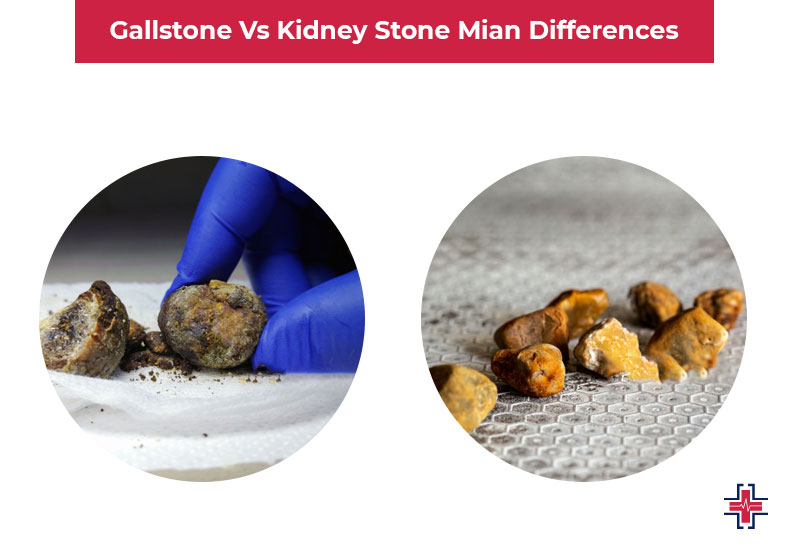
Kidney stones are crystals made of chemicals in the urine, whereas gallstones are deposits of digestive fluid. Stones of either kind may pass. The gallbladder may need to be removed due to gallstones. Similar names for two frequent medical disorders are kidney stones and gallstones.
Gallstone Diet Plan
Although there isn’t a single food that will prevent gallstones, the following may reduce your risk:
- Eat often. Bile from your liver is stored in your gallbladder, but it empties when you eat. For those who are predisposed to gallstones, doing this daily may help avoid the formation of gallstones.
- Eat a lot of plant-based foods. Fiber might assist in removing extra cholesterol from your body. Fruits, vegetables, beans, and whole grains like brown rice, oatmeal, and whole-wheat bread are examples of foods high in fiber.
- Opt for omega-3 and unsaturated fats. Gallstones are less common in those who consume higher amounts of omega-3 fatty acids (found in flaxseed, fish, and fish oil) and monounsaturated and polyunsaturated fats (found in olive oil, canola oil, and nuts).
FAQs
How can gallstone and fatty liver be removed?
- Exercise regularly can help you control your liver condition and lose weight.
- Reduced lipid levels in the blood. Reduce your intake of sugar and saturated fat to help control Your triglyceride and cholesterol levels.
- Control your diabetes.
What happens if a gallstone is left after surgery?
An intraperitoneal abscess may result from gallstones lost during laparoscopic cholecystectomy. Furthermore, they can go through the diaphragm, the front or posterior abdominal wall, and into the bronchus or urinary system.
How to stop gallstone pain while pregnant?
When a pregnant woman has biliary colic, she should abstain from food and liquids until the attack passes. To treat symptoms, patients may receive intravenous fluids and painkillers in the hospital. Cholecystectomy should be considered if these therapies are ineffective in treating biliary colic.
How serious is gallstone pancreatitis?
Serious consequences may arise from untreated gallstone pancreatitis. Liver, gallbladder, and pancreatic digestive secretions can back up into your body and cause cholangitis, an infection. Jaundice, or yellowing of the skin and eyes, is another possibility.
How to ease gallstone pain?
Try applying a warm compress to the afflicted area to relieve gallbladder pain. You might be able to take a magnesium supplement to aid in gallbladder emptying or sip peppermint tea to relieve the pain. You are limited in what you can do at home to alleviate the discomfort, though.
Summary
The prognosis is usually good if your physician at the ER of Mesquite – Emergency Room determines that you require surgery to remove your gallbladder or gallstones. After being removed, stones often don’t come back.
Gallstones can recur if you choose to take medicine to dissolve them instead of having surgery, so you and your doctor will need to keep an eye on your progress.
You probably won’t need to take any action if your gallstones aren’t creating any symptoms. Even so, you might wish to alter your way of living to stop them from growing larger and creating issues.
